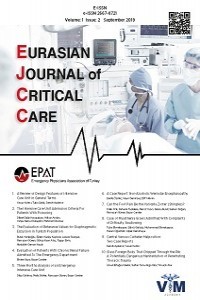A Review of Design Features of Intensive Care Unit in General Terms
A Review of Design Features of Intensive Care Unit in General Terms
Design, Intensive Care Unıt,
___
- 1- Minimum standards for intensive care units. IC-1 (2016). College of Intensive Care Medicine of Australia and New Zealand. Available at: https://www.cicm.org.au/CICM_Media/CICMSite/CICM-Website/Resources/Professional%20Documents/IC-1-Minimum-Standards-for-Intensive-Care-Units_1.pdf. Accessed August 5, 2019.
- 2- Çelikel T. Critical Care Medicine in the World and in Turkey. Turkish Journal of Intensive Care Medicine 2001; 1(1): 5-10.
- 3- Fiona E Kelly FE, Kevin Fong K, Nicholas Hirsch N and Nolan JP. Intensive care medicine is 60 years old: the history and future of the intensive care unit. Clinical Medicine 2014; 14 (4): 376–9.
- 4- American College of Critical Care Medicine of the Society of Critical Care Medicine. Critical care services and personnel: Recommendations based on a system of categorization into two levels of care. Crit Care Med 1999; 27:422-6.
- 5- 2. Faculty of Intensive Care, Australian and New Zeland College of Anesthetists (FICANZCA): Minimum standards for high dependency units seeking accreditation for training in intensive care. IC-13. Australian and New Zeland College of Anesthetists, Melbourne 2000:1-4.
- 6- 3. Guidelines/Practice Parameters Committee of the American College of Critical Care Medicine, Society of Critical Care Medicine: Guidelines for intensive care design. Crit Care Med, 1995; 23:582-8.
- 7- Guidelines on critical care services and personnel: Recommendations based on a system of categorization of three levels of care’’ Crit Care Med 2003; 31:2677-83.
- 8- Communiqué amending the communiqué on the principles and procedures for the application of intensive care services in inpatient health facilities. Official Gazette of the Republic of Turkey. Number: 30015.Available at: http://www.resmigazete.gov.tr/eskiler/2017/03/20170322-31.htm. Accessed August 5, 2019.
- 9- Thompson DR, Hamilton DK, Cadenhead CD, Swoboda SM, Schwinde SM, Anderson DC et all. Guidelines for intensive care unit design. Crit Care Med 2012; 40(5): 1586-1600.
- 10- Morandi A, Brummel NE, Ely EW. Sedation, delirium and mechanical ventilation: the 'ABCDE' approach. Curr Opin Crit Care. 2011; 17(1):43-9.
- Başlangıç: 2019
- Yayıncı: Acil Tıp Uzmanları Derneği
The Evaluation of Referance Values for Diaphragmatic Excursion in Turkish Population
Burak KATİPOĞLU, Eylem KUDAY KAYKISIZ, Lukasz SZARPAK, Ramazan GÜVEN, Gökçe Kaan ATAÇ, Togay EVRİN, Abdullah Osman KOÇAK
Case of Myasthenia Gravis Admitted With Complaints of Difficulty Swallowing
Tuba EKMEKYAPAR, Şükrü GÜRBÜZ, Muhammed EKMEKYAPAR, Hakan OĞUZTÜRK, Alper DEMİRKAYA
Can the Foot Pain Be the Varicella Zoster (Shingles)?
Dilek ATİK, Bahadır TAŞLIDERE, Ramiz YAZICI, Bensu BULUT, Serkan DOĞAN, Ramazan GÜVEN, Başar CANDER
Evaluation of Patients with Chronic Renal Failure Admitted to the Emergency Department
İsmail Ertuğrul GEDİK, Sultan Tuna AKGÖL GÜR, Timuçin ALAR
Central Venous Catheter Malposition: Two Case Reports
The Intensive Care Unit Admission Criteria For Patients With Poisoning
Dilber ÜÇÖZ KOCAŞABAN, Volkan ARSLAN, Yahya Kemal GÜNAYDIN, Mehmet OKUMUŞ
A Review of Design Features of Intensive Care Unit in General Terms
Yavuz KATIRCI, Tuba ŞAFAK, Semih AYDEMİR
A Case Report: Non-Alcoholic Wernicke Encephalopathy
Şerife ÖZDİNÇ, Hayri DEMİRBAŞ, Elif YILDIRIM
